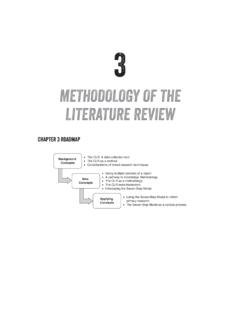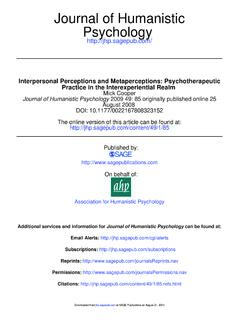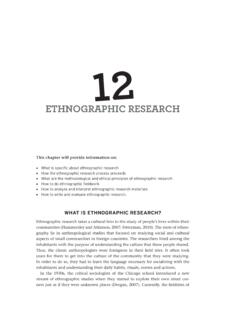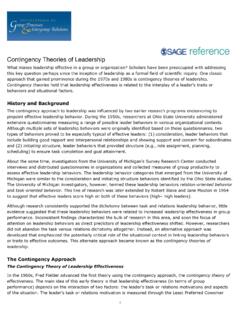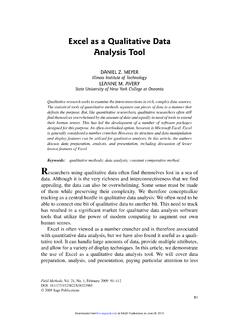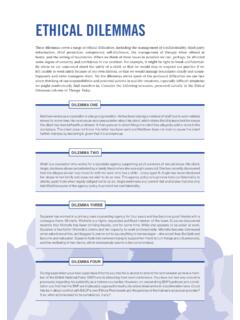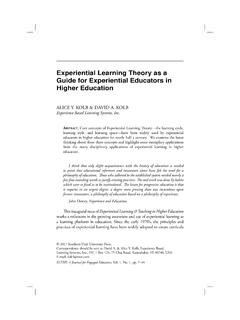Transcription of Embedded Case Study Methods TYPES OF CASE STUDIES
1 Embedded Case Study MethodsTYPES OF CASE STUDIESC ontributors: Roland W. Scholz & Olaf TietjeEditors: Roland W. Scholz & Olaf TietjeBook Title: Embedded Case Study MethodsChapter Title: " TYPES OF CASE STUDIES "Pub. Date: 2002 Access Date: October 15, 2013 Publishing Company: SAGE Publications, : Thousand OaksPrint ISBN: 9780761919452 Online ISBN: 9781412984027 DOI: pages: 9-15 This PDF has been generated from SAGE Research Methods . Please note that thepagination of the online version will vary from the pagination of the print 2013 SAGE Research MethodsPage 2 of 7 Embedded Case Study Methods : TYPES OF OF CASE STUDIES [p. 9 ]The case Study approach presented is an empirical inquiry that investigates acontemporary problem within its real-life context.
2 Understanding the problem and itssolution requires integrating a myriad of mutually dependent variables or pieces ofevidence that are likely to be gathered at least partially by personal a common definition of case STUDIES exists, one may encounter various typesof case STUDIES (see Table ). In order to make clear to which type of case Study theintroduced Methods of knowledge integration should be applied, we will briefly describedifferent TYPES of case STUDIES . A detailed review of case STUDIES is given by Yin (1994).DESIGNH olistic Versus EmbeddedA crucial distinction must be made between holistic and Embedded case STUDIES (Yin,1994, p. 41). A holistic case Study is shaped by a thoroughly qualitative approach thatrelies on narrative, phenomenological descriptions.
3 Themes and hypotheses may beimportant but should remain subordinate to the understanding of the case (Stake, 1976,p. 8). Embedded case STUDIES involve more than one unit, or object, of analysis and usuallyare not limited to qualitative analysis alone. The multiplicity[p. 10 ] of evidence isinvestigated at least partly in subunits, which focus on different salient aspects of thecase. In an organizational case Study , for example, the main unit may be a company asa whole, and the smallest units may be departments or even groups of individuals, suchas owners and employees. In a clinical, neuropsychological case Study , the units maybe organized along biographically critical events in the childhood or the vocational worldSAGEC opyright 2013 SAGE Research MethodsPage 3 of 7 Embedded Case Study Methods : TYPES OF CASESTUDIESof the case.
4 In case STUDIES on regional or urban planning, the units may be differentinterest groups that are involved or affected by the Dimensions and Classifications of Case StudiesNote that an Embedded case Study allows for a multiplicity of Methods that may beapplied within the subunits. Thus, hypotheses may be formulated, quantitative datasampled, or statistical analyses applied (see Bortz & D ring, 1995; Campbell & Stanley,1963). As the title of the book suggests, this book presents Methods of Embedded casestudies (see Part III).Single Case Versus Multiple CaseAnother design characteristic of a case Study is whether the design is single case ormultiple case. There may be different reasons for choosing a[p.]
5 11 ] single-casedesign. A case may be considered unique, prototypical, salient, or revelatory to theunderstanding of a phenomenon or problem. Analogous to Newton's experimentumcrucis, it may even be the critical case in testing a well-formulated theory. Althoughthere is no common understanding of how to integrate separate single-case studiesinto a joint multiple-case design, it is most important to note that the synthesis processbetween the single cases does not follow a statistical sampling rationale. As Yin (1994)notes, Every case should serve a specific purpose within the overall scope of , a major insight is to consider multiple cases as one would consider multipleexperiments that is, to follow a replication logic (p.)
6 45).SAGEC opyright 2013 SAGE Research MethodsPage 4 of 7 Embedded Case Study Methods : TYPES OF CASESTUDIESMOTIVATIONThe case Study researcher often feels intrinsically motivated to investigate a certaincase for nonscientific reasons. This may hold true for a new type of educational orpublic health program, or a specific project in urban development. If there is intrinsicinterest, the Study team usually takes responsibility and is accountable for the analysisand its consequences (see Gibbons et al., 1994). But if the objective of the studyis something other than understanding the particular case, then the inquiry is aninstrumental case illustrate the difference between these TYPES of STUDIES , consider the characters oftwo different physicians.
7 A physician with an intrinsic motivation is personally interestedin and feels responsible for the patient. A physician with an instrumental motivationis primarily interested in using anamnestic and laboratory data to further scientific orfinancial objectives, and is less interested in the case STATUSThe label case Study is most frequently associated with the exploratory case Study . Itusually precedes a final Study , which can, itself, be a case Study , but it can also havea different research design (Boos, 1992). Exploratory case STUDIES help to gain insightinto the structure of a phenomenon in order to develop hypotheses, models, or exploratory Study very much resembles a pilot Study ; the research design and datacollection Methods usually are not specified in advance.
8 [p. 12 ]A descriptive case Study differs from an exploratory Study in that it uses a referencetheory or model that directs data collection and case description. In some respects, adescriptive case Study tests whether and in what way a case may be described whenapproaching it from a certain perspective. Many Formative Scenario Analyses may beconsidered typical of this type of Study (see Chapter 9).SAGEC opyright 2013 SAGE Research MethodsPage 5 of 7 Embedded Case Study Methods : TYPES OF CASESTUDIESE xplanatory case STUDIES can also serve to test cause-and-effect relationships. Clearly,according to conventional understanding of theory testing, a single case can only falsifya theory. However, a case may also be used for theory testing, either if the case isused for quantitative data sampling (see Petermann, 1989), or, in a replication logic,if the research team investigates whether similar causal events within each case produce these positive outcomes (Yoon & Hwang, 1995, p.)
9 12). Note that the theorytesting is done in a qualitative manner. However, as in traditional hypothesis testing,specifications for the cause-impact chain have to be formulated before case case Study may be used as a method of research, teaching , or action/ instructional purposes, case STUDIES are commonly used in business, law, andmedical schools. The case encounter quite often changes the traditional educationalapproach into a discussion pedagogy. Thus, the case method is a variation on theSocratic method, which is another name for proactive interaction between teachers andstudents (Ronstadt, 1993). Unfortunately, when teaching by case STUDIES (see Barneset al., 1994), the primacy of data and of situation analysis is often not respected as aprinciple.
10 This is due to the fact that a prepared, written case offers only limited accessto data, and, therefore, teaching case STUDIES are based on a virtual process of basic formats for case STUDIES exist (Ronstadt, 1993, pp. 17 18). The first twotypes are teaching cases and are always provided in written form.[p. 13 ]SAGEC opyright 2013 SAGE Research MethodsPage 6 of 7 Embedded Case Study Methods : TYPES OF CASESTUDIESDATA COLLECTION AND Methods OFKNOWLEDGE INTEGRATIONIn principle, each case Study should use multiple sources of information. All methodsshould employ direct and participant observations, structured interviews, and surveys,and they can also include experimental design, focused interviews, open-endedinterviews, archival records, documents, and scientific data from field and laboratory(see Box ).

